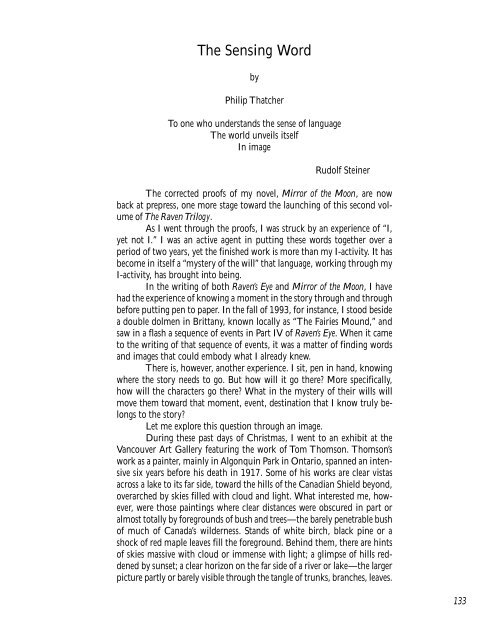Colloquium on English - Research Institute for Waldorf Education
Colloquium on English - Research Institute for Waldorf Education
Colloquium on English - Research Institute for Waldorf Education
Create successful ePaper yourself
Turn your PDF publications into a flip-book with our unique Google optimized e-Paper software.
The Sensing Word<br />
by<br />
Philip Thatcher<br />
To <strong>on</strong>e who understands the sense of language<br />
The world unveils itself<br />
In image<br />
Rudolf Steiner<br />
The corrected proofs of my novel, Mirror of the Mo<strong>on</strong>, are now<br />
back at prepress, <strong>on</strong>e more stage toward the launching of this sec<strong>on</strong>d volume<br />
of The Raven Trilogy.<br />
As I went through the proofs, I was struck by an experience of “I,<br />
yet not I.” I was an active agent in putting these words together over a<br />
period of two years, yet the finished work is more than my I-activity. It has<br />
become in itself a “mystery of the will” that language, working through my<br />
I-activity, has brought into being.<br />
In the writing of both Raven’s Eye and Mirror of the Mo<strong>on</strong>, I have<br />
had the experience of knowing a moment in the story through and through<br />
be<strong>for</strong>e putting pen to paper. In the fall of 1993, <strong>for</strong> instance, I stood beside<br />
a double dolmen in Brittany, known locally as “The Fairies Mound,” and<br />
saw in a flash a sequence of events in Part IV of Raven’s Eye. When it came<br />
to the writing of that sequence of events, it was a matter of finding words<br />
and images that could embody what I already knew.<br />
There is, however, another experience. I sit, pen in hand, knowing<br />
where the story needs to go. But how will it go there? More specifically,<br />
how will the characters go there? What in the mystery of their wills will<br />
move them toward that moment, event, destinati<strong>on</strong> that I know truly bel<strong>on</strong>gs<br />
to the story?<br />
Let me explore this questi<strong>on</strong> through an image.<br />
During these past days of Christmas, I went to an exhibit at the<br />
Vancouver Art Gallery featuring the work of Tom Thoms<strong>on</strong>. Thoms<strong>on</strong>’s<br />
work as a painter, mainly in Alg<strong>on</strong>quin Park in Ontario, spanned an intensive<br />
six years be<strong>for</strong>e his death in 1917. Some of his works are clear vistas<br />
across a lake to its far side, toward the hills of the Canadian Shield bey<strong>on</strong>d,<br />
overarched by skies filled with cloud and light. What interested me, however,<br />
were those paintings where clear distances were obscured in part or<br />
almost totally by <strong>for</strong>egrounds of bush and trees—the barely penetrable bush<br />
of much of Canada’s wilderness. Stands of white birch, black pine or a<br />
shock of red maple leaves fill the <strong>for</strong>eground. Behind them, there are hints<br />
of skies massive with cloud or immense with light; a glimpse of hills reddened<br />
by sunset; a clear horiz<strong>on</strong> <strong>on</strong> the far side of a river or lake—the larger<br />
picture partly or barely visible through the tangle of trunks, branches, leaves.<br />
133

















